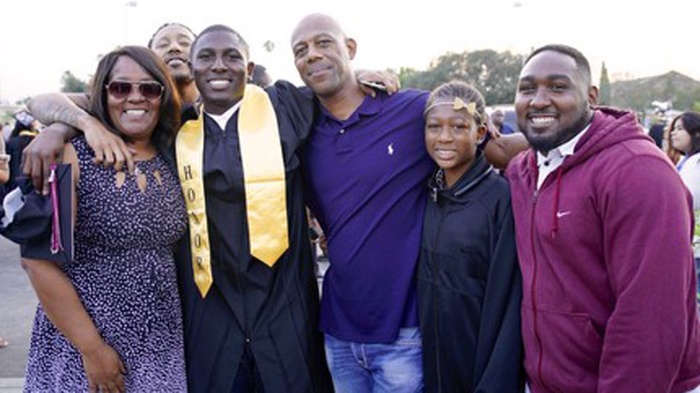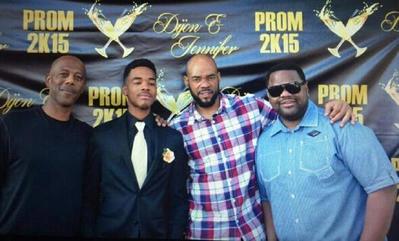How should journalists write about killings near schools? The students weigh in
In spring 2018, about a dozen students from two South Los Angeles high schools — Fremont and Manual Arts — participated in a round-table discussion at the offices of the nonprofit organization Community Coalition, where the students are involved in advocacy and community-building.
They read a story from The Times' Homicide Report about Maurice McKinzy, who was killed just blocks from Fremont High School in 2017, and talked about the kind of coverage they want to see about their communities, as well as their experience trying to stay safe in their neighborhoods.
The story below is annotated with the comments that they wrote or said during the discussion. Their words are unedited.
Friends mourn father and former basketball coach: ‘He was the dad everybody wishes they had’
 POSTED MARCH 8, 2017, 5 A.M.
Maurice McKinzy was checking out a Camry that a friend had purchased for his daughter, blocks away from where McKinzy had grown up.
About 10:30 p.m. on Feb. 1, McKinzy, 45, and his friends saw a group of at least three approach, police said.
McKinzy began walking back to his car in the 7500 block of South Main Street when he was shot at least five times with a high-powered weapon, according to coroner’s records.
Geovanni Jimenez, 18 If violence was a cause for his death, the person who wrote this should have implemented things about gun violence in general, factors like the history of gun violence in general or what types of actions were implemented by police or the community to stop this, or if action was taken at all.
Darrell Valle, 17 You guys should add that there’s communities here trying to make a change.
POSTED MARCH 8, 2017, 5 A.M.
Maurice McKinzy was checking out a Camry that a friend had purchased for his daughter, blocks away from where McKinzy had grown up.
About 10:30 p.m. on Feb. 1, McKinzy, 45, and his friends saw a group of at least three approach, police said.
McKinzy began walking back to his car in the 7500 block of South Main Street when he was shot at least five times with a high-powered weapon, according to coroner’s records.
Geovanni Jimenez, 18 If violence was a cause for his death, the person who wrote this should have implemented things about gun violence in general, factors like the history of gun violence in general or what types of actions were implemented by police or the community to stop this, or if action was taken at all.
Darrell Valle, 17 You guys should add that there’s communities here trying to make a change.
“We don’t know why he would have been targeted,” said Los Angeles Police Det. Eric Crosson. Police are still searching for the gunman. McKinzy, a traffic officer at Los Angeles International Airport, was a father to a 19-year-old son and an 11-year-old daughter. He had helped raise two stepchildren and was a former junior varsity and assistant varsity basketball coach at John C. Fremont High School, about a half a mile from the scene of the shooting. Bianca Garcia, 18They didn’t really put him in a box about being a criminal or something. I found that kind of shocking because usually when someone gets a highlight in article about being killed, they usually put him into that box that like he did this, he did that, he was black and all of that.
“He was the last person I would think something like this would happen to,” said Louis Austin, 46. Austin and McKinzy grew up in the same neighborhood and were friends since the seventh grade. For McKinzy, the rows of houses and duplexes in Florence and the people who lived there were familiar. His grandmother once lived there, and his mother was raised there. Ericka Hayes, 15I like how they didn’t stigmatize the fact that he lived in South Central and that he grew up in South Central. They said he was a person, it didn’t matter where he grew up, the color of his skin was. He was a person, he got killed for a stupid reasons.
Many of his childhood friends were still in the area, and some young people knew him from his time coaching basketball. For his friends and family, the reality that McKinzy was shot in a community where he had made a positive influence is devastating. “That’s what’s so tragic. That man grew up in that area his entire life. It was never an issue for him. They knew he was a basketball player, and they knew he was a coach,” said Heather Echols, the mother of McKinzy’s son, Marquis. Darrell Valleyou guys should add little bit more of gang violence and how its something even “good” people have to go threw.
Growing up, McKinzy and Austin had to navigate the violence in their South Los Angeles neighborhood. Walking home from school meant crossing through rival gangs’ territory. But the two friends stayed out of trouble, choosing instead to be athletes. In 1989, their basketball team won a city championship, and McKinzy was the captain, Austin said. A few years after high school, McKinzy came back to coach the students. He became known as the guy who could build up a player’s busted self-esteem. He was more than an authority figure in the students’ lives; he was also someone they could look up to. At one point, McKinzy bought a large SUV to be able to drive students home. Kimberly Carrillo, 17I’m actually scared to walk to school. Although Fremont is only three minutes away from my house, my mom actually takes my brother and I to school for our own safety. I live on the Avalon side toward Central, and you usually see a liquor store toward the territory over there, and that one is very known for drive-bys to occur within that place. So it’s very scary to even walk to school and going home. Geovanni JimenezIt resonates with me because it’s a fairly accurate depiction of our day to day lives. Students that commute to school, jobs, just walking in the park or something, it’s a day to day struggle because a type of color you’re wearing could like implement that you’re in a gang or something, there’s still racially motivated gang violence around here. It’s not as prominent as it used to be, but it still occurs. These tiny things have a big implication on our lives.
“He was the dad everybody wishes they had,” Echols said. When Echols met McKinzy in the mid-1990s, she had recently separated from her husband and had two young children. McKinzy quickly began treating them as his own. Though the relationship didn’t work out, Echols and McKinzy remained close, and McKinzy sometimes referred to their family as the “McEchols.’” Geovanni Jimenez A lot of people in South LA don’t have the most stable homes, they don’t have housing, they don’t have a lot of things that other people would. The fact that you look for surrogate father or surrogate mother in your schools, it’s actually a thing that happens. You find people that you can connect with, that would be a teacher, a counselor, or a friend. But you find those people and you make them your second family because in this neighborhood you never know who’s going to stick around for the long run.
In 2012, McKinzy quit coaching so he could be available for son Marquis’ basketball games. “If he had to switch his schedule or sneak out … whatever he had to do, he’d figure it out,” Echols said. Ericka HayesThere should be more on how the students feel about this.
McKinzy was also known as a “surrogate father” for young people around him, said George McLin, who grew up with McKinzy and Austin and is now the basketball coach at Fremont High School.
“He was there to take my son to practice; he was there to pick my son up from practice,” McLin said. “He literally helped raise my son.”
When Austin’s son, Dijon, went to the prom in 2015, Austin was preoccupied with prepping his home for a gathering. Amid the frenzy, he found McKinzy helping the teenager with his tuxedo.
 McKinzy nodded at Austin. It was taken care of.
“The next thing I know, my son comes out sharp and together,” Austin said.
McKinzy’s recent ex-girlfriend, Trina McGrew, said McKinzy was a homebody. It wasn’t like him to be out late at night.
Tania Sanchez, 16I feel it’s very important that this article did not racially profile him, because in many news, they show him in street clothes instead of like — You know? I don’t know if you know — but they make them look like the bad guy, “That’s why he got shot. Because he was bad.”
McKinzy nodded at Austin. It was taken care of.
“The next thing I know, my son comes out sharp and together,” Austin said.
McKinzy’s recent ex-girlfriend, Trina McGrew, said McKinzy was a homebody. It wasn’t like him to be out late at night.
Tania Sanchez, 16I feel it’s very important that this article did not racially profile him, because in many news, they show him in street clothes instead of like — You know? I don’t know if you know — but they make them look like the bad guy, “That’s why he got shot. Because he was bad.”
“He was the type of person where he was just content with staying at home and watching movies,” she said. Recently, Echols reflected on McKinzy’s death as she packed up McKinzy’s apartment in Wilmington. There was the notebook tracking his dominoes games. There were stacks of photographs, photo albums and Raiders and Lakers mementos. “My initial response was, how dare you take this man from us in this fashion? Not that guy,” she said. “Now it’s just sadness and sorrow.” Fernando Mosqueda, 17This story seems more as a report (which may be the intention) but i think there needs be all call-to-action. What are the root causes of gang violence? What are the solutions and next steps? I think this would be great to plug into the bigger picture of gang violence, gun violence, and overall the safety of black and brown people, particularly youth of color. Recognize the connection between zip codes to life expectancy and color to discrimination and historical problems.
Anyone with information is asked to call the LAPD Criminal Gang Homicide Division at (323) 786-5113. Those who wish to remain anonymous can call Crime Stoppers at (800) 222-8477. Photo: Maurice McKinzy, third from left, at son Marquis’ high school graduation in 2016. Credit: Courtesy of Heather Echols Photo, right: Maurice McKinzy, far left, with Dijon Austin, Louis Austin and George McLin on Dijon’s prom night in 2015. Credit: Courtesy of Louis Austin Contact the Homicide Report. Follow @nicolesantacruz and @latimeshomicide on Twitter
Support our journalism
This series is a product of The Homicide Report, The Times' effort to tell the story of every homicide victim in Los Angeles County.
Please consider subscribing today to support more stories like this. Get full access to our journalism for just 99 cents for the first four weeks. Already a subscriber? Your support makes our work possible. Thank you.




